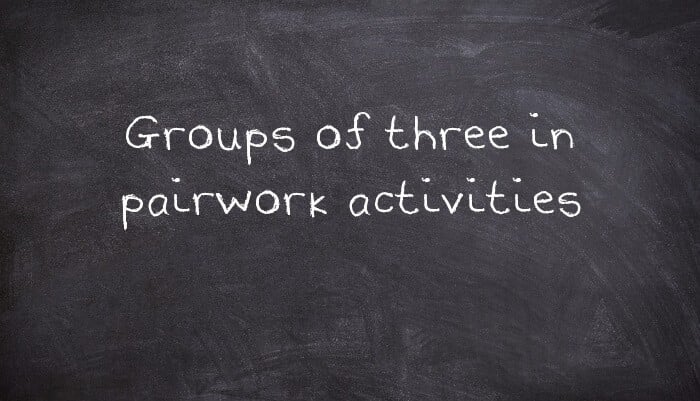Groups of three students can be a complication for a teacher who is planning pairwork, sometimes even one that can panic the teacher and/ or ruin the lesson. However, it can also be an interesting choice for a teacher who wants to mix things up in class a little. This article will deal with the first of those situations, with the more positive choice being dealt with in another article.
What to do if you have a group of three students when doing pairwork
Statistically, around half of all classes will have an odd number of students and so have an extra student when you plan to split them into Student A and Student B pairs. This situation can also happen unexpectedly because someone is absent. Techniques to cope with an odd number of students include:
- when you have finished giving instructions on pairwork to the whole class and asked them to start working together, rush to the group of three to show them how to do it that way
- ask two students to share the Student B worksheet/ Student B role
- ask two students to split the Student B role (taking turns line by line, switching halfway through, etc)
- create a Student C worksheet for any odd-numbered groups, then maybe hurry that group along so that they finish at the same time as the smaller groups
- create a Student C worksheet for the odd-numbered group, and also give that to Student A in any pairs which finish early
- create a Student C worksheet and put the whole class into groups into threes if there are nine students, fifteen students, etc
- create a slightly different version of the activity for the group of three (see below)
- give the third student a different role such as helping the other two speak 50/ 50, then make sure that they get a main speaking role in the next activity
- ask the third student to wait or do something different the first time, then ask a different student in their group to wait when you give out a related Students A and B activity
- give the odd student a role monitoring, helping or supervising the whole class
- when you change groups, make sure that the students from the group of three are all now in pairs
- keep a note of who has been in groups of three so they don’t end up that way in every class (because they always sit at the end of the line of students, etc)
Possible roles for third students
Ways of changing an activity to match three students include:
- a receptionist to speak to before they get through to the third person
- someone more expert who an email is forwarded to
- a shop manager who comes over to help
- someone who deals with payment after goods are chosen
- a maître d’ who greets guests
- someone who orders are passed onto, e.g. warehouse staff
- a separate wine waiter or dessert waiter
Things third students can do while waiting
Things that the third student can do while their partners do an activity include writing down feedback, writing down useful language that they hear and would like to use, chairing the meeting, timing the activity, ticking off language that is used from a worksheet, explaining and enforcing the rules of the game, providing background noises, and interrupting the conversation to make it more challenging.
An easy way to create Student C worksheets
It is difficult to create a Student C worksheet for activities such as information gaps like picture differences. However, with worksheets which are simply a list of things to use like discussion questions, the teacher can simply cut off the end of Student A’s and Student B’s worksheets and put them together to make a Student C version (along with the shorter versions of the other two).
